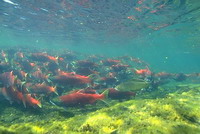Login form
Ecosystem
 Colorful tropical fish swim through warm water around a coral reef. The fish are part of the coral reef ecosystem. Beautiful orchids grow on trees that tower above the rain forest floor. The orchids and the trees are part of the rain forest ecosystem. A hawk swoops down on a rabbit hopping through the tall grass of a prairie. The hawk, rabbit, and grass are part of the prairie ecosystem.
Colorful tropical fish swim through warm water around a coral reef. The fish are part of the coral reef ecosystem. Beautiful orchids grow on trees that tower above the rain forest floor. The orchids and the trees are part of the rain forest ecosystem. A hawk swoops down on a rabbit hopping through the tall grass of a prairie. The hawk, rabbit, and grass are part of the prairie ecosystem.
WHAT IS AN ECOSYSTEM?
An ecosystem is all the living and nonliving things in a certain area. All the plants and animals, even the microorganisms that live in the soil, are living parts of an ecosystem. Air, water, and rocks are nonliving parts of an ecosystem.
Ecosystems are smaller parts of all the living environments on Earth. Earth’s entire living environment is called the biosphere. The biosphere is made up of large areas called biomes. Land biomes include grasslands, deserts, coniferous forests (forests of cone-bearing trees), deciduous forests (forests of trees that shed their leaves), and tropical rain forests. There are also biomes in bodies of water, such as the ocean.
The biomes, in turn, are made up of many ecosystems. The desert biome, for example, covers all the deserts of the world. Each individual desert is an ecosystem. The Mojave Desert in California is a desert ecosystem.
WHY DOES AN ECOSYSTEM NEED PARTS?
Every living thing in an ecosystem depends in some way upon other living and nonliving things in the ecosystem. All the parts of an ecosystem work together.
The living things in an ecosystem are either producers or consumers. Producers do not eat other living things. Producers make food. Trees, grasses, and other green plants make food. Green plants are called primary producers. Plants use nonliving nutrients—nourishing substances, such as the chemicals in soil and water—to help them make food. They use energy in sunlight to make food. They also use carbon dioxide gas in air to make food.
Consumers are animals that eat other living things. Animals that only eat plants are called herbivores. Herbivores are primary consumers. Rabbits, mice, and plant-eating insects are primary consumers.
Animals that eat other animals are called carnivores. Carnivores are secondary consumers. Bears and hawks are secondary consumers.
Ecosystems also have decomposers. Decomposers break down dead plants and animals. They break down animal wastes. Fungi, such as mushrooms and mold, and bacteria are decomposers. They turn dead material and waste into chemical nutrients. Plants take up the nutrients with their roots. They use the nutrients to make more food.
HOW BIG IS AN ECOSYSTEM?
Some ecosystems are huge, and some are small. A tropical rain forest ecosystem might cover hundreds of square miles. A mangrove swamp ecosystem might stretch only a few miles along the shore of an island.
A place can have more than one ecosystem. A rain forest and a mangrove swamp could be on the same island. A coral reef ecosystem might be in the water around the island.
HOW DOES AN ECOSYSTEM WORK?
All things in an ecosystem are connected with one another. These connections come through food and energy. The energy comes from the Sun. Plants use the energy in sunlight to make food. Animals eat the plants. Other animals eat the plant-eating animals. The way energy flows in food from plants to animals is called a food chain. Food chains that overlap are called food webs.
Let’s look at an ecosystem in a forest. Water flowing in a river makes the riverbanks wet. Plants that need lots of water grow along the riverbanks. Insects feed on plants in or along the river. A salmon swimming by eats the insects that fall in the water. A brown bear that lives in the forest wades into the river and swipes its paw in the water. The bear catches and eats the salmon.
The bear tosses the salmon bones and some meat onto the riverbank. Bacteria and fungi now go to work. The tiny bacteria and fungi feed upon the remains of the salmon. They break down the salmon into chemical nutrients. Nutrients from the salmon go into the soil.
The roots of plants along the riverbank take up the nutrients. They use the nutrients to make food. In this way, nutrients get recycled back through the ecosystem.
WHAT CAN HARM AN ECOSYSTEM?
Any change in one living or nonliving part of an ecosystem can cause changes in other parts. Droughts, storms, and fires can change ecosystems. Some changes harm ecosystems. If there is too little rainfall, plants will not have enough water to live. If a kind of plant dies off, the animals that fed on it may also die or move away.
Some changes are good for ecosystems. Some pine forests need fires for the pine trees to reproduce. The seeds are sealed inside pinecones. Heat from a forest fire melts the seal and lets the seeds out.
Polluting the air, soil, and water can harm ecosystems. Building dams on rivers for electric power and irrigation can harm ecosystems around the rivers. Bulldozing wetlands and cutting down forests destroys ecosystems.
Ecologists are working with companies and governments to find better ways of catching fish, cutting down trees, and building dams. They are looking for ways to get food, lumber, and other products for people without causing harm to ecosystems.
Source: Microsoft ® Encarta

